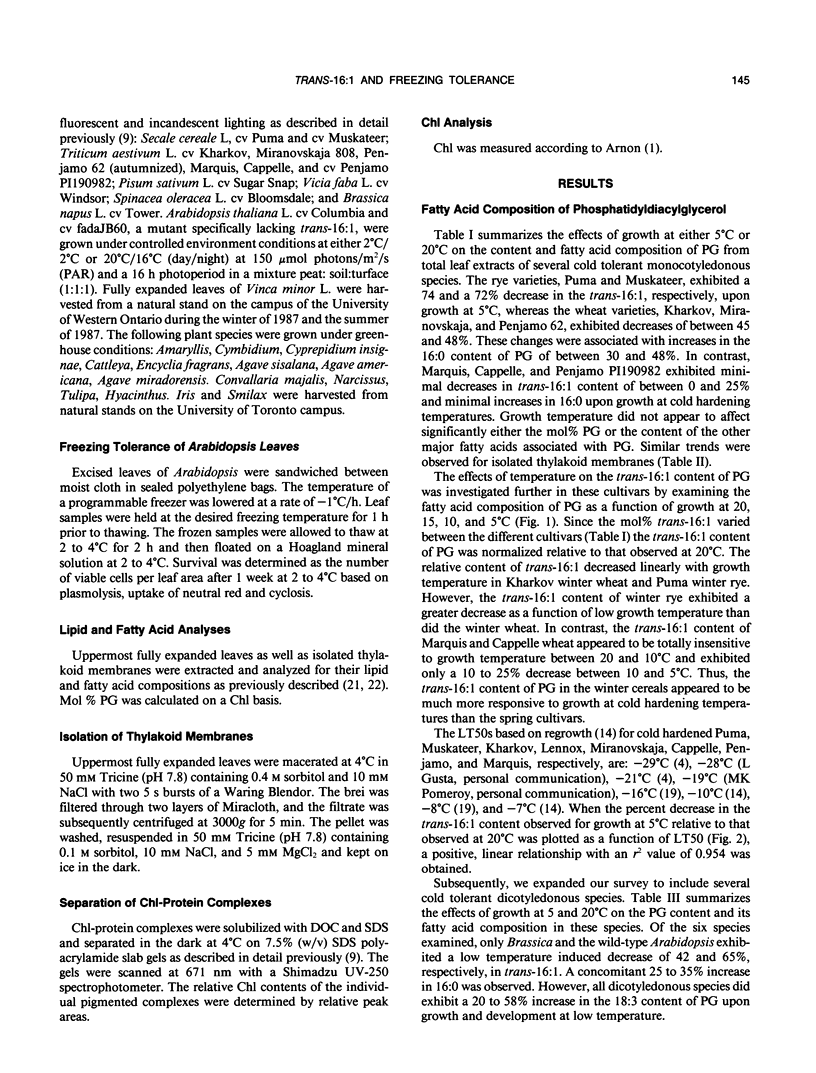Abstract
The effect of growth at 5°C on the trans-Δ3-hexadecenoic acid content of phosphatidyl(d)glycerol was examined in a total of eight cultivars of rye (Secale cereale L.) and what (Triticum aestivum L.) of varying freezing tolerance. In these monocots, low temperature growth caused decreases in the trans-Δ3-hexadecenoic acid content of between 0 and 74% with concomitant increases in the palmitic acid content of phosphatidyl(d)glycerol. These trends were observed for whole leaf extracts as well as isolated thylakoids. The low growth temperature-induced decrease in the trans-Δ3-hexadecenoic acid content was shown to be a linear function (r2 = 0.954) of freezing tolerance in these cultivars. Of the six cold tolerant dicotyledonous species examined, only Brassica and Arabidopsis thaliana L. cv Columbia exhibited a 42% and 65% decrease, respectively, in trans-Δ3-hexadecenoic acid content. Thus, the relationship between the change in trans-Δ3-hexadecenoic acid content of phosphatidyl(d)glycerol and freezing tolerance cannot be considered a general one for all cold tolerant plant species. However, species which exhibited a low growth temperature-induced decrease in trans-Δ3-hexadecenoic acid also exhibited a concomitant shift in the in vitro organization of the light harvesting complex II from a predominantly oligomeric form to the monomeric form. We conclude that the proposed role of phosphatidyl(d)glycerol in modulating the organization of light harvesting complex II as a function of growth temperature manifests itself to varying degrees in different plant species. A possible physiological role for this phenomenon with respect to low temperature acclimation and freezing tolerance in cereals is discussed.
Full text
PDF






Selected References
These references are in PubMed. This may not be the complete list of references from this article.
- Arnon D. I. COPPER ENZYMES IN ISOLATED CHLOROPLASTS. POLYPHENOLOXIDASE IN BETA VULGARIS. Plant Physiol. 1949 Jan;24(1):1–15. doi: 10.1104/pp.24.1.1. [DOI] [PMC free article] [PubMed] [Google Scholar]
- Browse J., McCourt P., Somerville C. R. A mutant of Arabidopsis lacking a chloroplast-specific lipid. Science. 1985 Feb 15;227(4688):763–765. doi: 10.1126/science.227.4688.763. [DOI] [PubMed] [Google Scholar]
- Burke J. J., Ditto C. L., Arntzen C. J. Involvement of the light-harvesting complex in cation regulation of excitation energy distribution in chloroplasts. Arch Biochem Biophys. 1978 Apr 15;187(1):252–263. doi: 10.1016/0003-9861(78)90031-0. [DOI] [PubMed] [Google Scholar]
- Griffith M., Huner N. P., Kyle D. J. Fluorescence Properties Indicate that Photosystem II Reaction Centers and Light-Harvesting Complex Are Modified by Low Temperature Growth in Winter Rye. Plant Physiol. 1984 Oct;76(2):381–385. doi: 10.1104/pp.76.2.381. [DOI] [PMC free article] [PubMed] [Google Scholar]
- Huner N. P., Krol M., Williams J. P., Maissan E., Low P. S., Roberts D., Thompson J. E. Low Temperature Development Induces a Specific Decrease in trans-Delta-Hexadecenoic Acid Content which Influences LHCII Organization. Plant Physiol. 1987 May;84(1):12–18. doi: 10.1104/pp.84.1.12. [DOI] [PMC free article] [PubMed] [Google Scholar]
- Krupa Z., Huner N. P., Williams J. P., Maissan E., James D. R. Development at Cold-Hardening Temperatures : The Structure and Composition of Purified Rye Light Harvesting Complex II. Plant Physiol. 1987 May;84(1):19–24. doi: 10.1104/pp.84.1.19. [DOI] [PMC free article] [PubMed] [Google Scholar]
- Lynch D. V., Steponkus P. L. Plasma Membrane Lipid Alterations Associated with Cold Acclimation of Winter Rye Seedlings (Secale cereale L. cv Puma). Plant Physiol. 1987 Apr;83(4):761–767. doi: 10.1104/pp.83.4.761. [DOI] [PMC free article] [PubMed] [Google Scholar]
- McCourt P., Browse J., Watson J., Arntzen C. J., Somerville C. R. Analysis of Photosynthetic Antenna Function in a Mutant of Arabidopsis thaliana (L.) Lacking trans-Hexadecenoic Acid. Plant Physiol. 1985 Aug;78(4):853–858. doi: 10.1104/pp.78.4.853. [DOI] [PMC free article] [PubMed] [Google Scholar]
- Vigh L., Horvàth I., van Hasselt P. R., Kuiper P. J. Effect of frost hardening on lipid and Fatty Acid composition of chloroplast thylakoid membranes in two wheat varieties of contrasting hardiness. Plant Physiol. 1985 Nov;79(3):756–759. doi: 10.1104/pp.79.3.756. [DOI] [PMC free article] [PubMed] [Google Scholar]
- Waldron J. C., Anderson J. M. Chlorophyll-protein complexes from thylakoids of a mutant barley lacking chlorophyll b. Eur J Biochem. 1979 Dec 17;102(2):357–362. doi: 10.1111/j.1432-1033.1979.tb04250.x. [DOI] [PubMed] [Google Scholar]
- Williams J. P., Watson G. R., Khan M. U., Leung S. Galactolipid Synthesis in Vicia faba Leaves: I. Galactose, Glycerol, and Fatty Acid Labeling after CO(2) Feeding. Plant Physiol. 1975 Jun;55(6):1038–1042. doi: 10.1104/pp.55.6.1038. [DOI] [PMC free article] [PubMed] [Google Scholar]
- Williams J. P., Watson G. R., Leung S. P. Galactolipid Synthesis in Vicia faba Leaves: II. Formation and Desaturation of Long Chain Fatty Acids in Phosphatidylcholine, Phosphatidylglycerol, and the Galactolipids. Plant Physiol. 1976 Feb;57(2):179–184. doi: 10.1104/pp.57.2.179. [DOI] [PMC free article] [PubMed] [Google Scholar]


